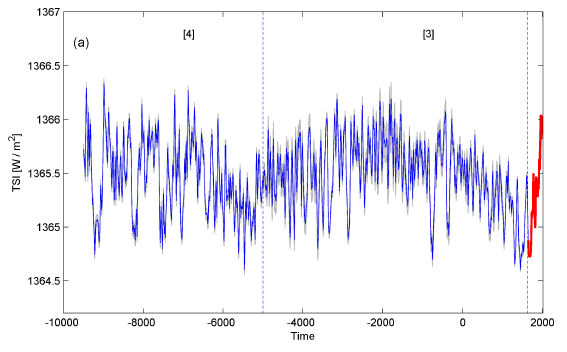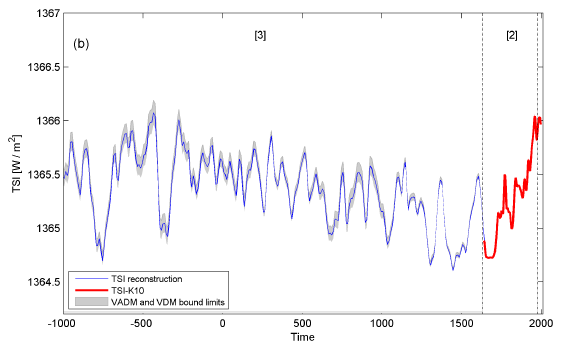Solar Hockey Stick
Posted on 13 April 2011 by dana1981
Vieira et al. recently posted a paper on arXiv preprint service which will later be published in the journal Astronomy & Astrophysics on a reconstruction of total solar irradiance (TSI) over the Holocene (the past 11,500 years). The scientists reconstruct TSI using a reconstruction of the solar magnetic flux.
"The evolution of the decadally averaged magnetic flux is computed from decadal values of cosmogenic isotope concentrations recorded in natural archives employing a series of physics-based models connecting the processes from the modulation of the cosmic ray flux in the heliosphere to their record in natural archives...We present the first physics-based reconstruction of the total solar irradiance over the Holocene, which will be of interest for studies of climate change over the last 11500 years. The reconstruction indicates that the decadally averaged total solar irradiance ranges over approximately 1.5 W/m2 from grand maxima to grand minima."
Vieira et al. provide figures depicting their TSI reconstruction over various periods, including the entire Holocene (Figure 1) and the past 3,000 years (Figure 2).

Figure 1: Vieira TSI reconstruction over the past 11,500 years

Figure 2: Vieira TSI reconstruction over the past 3,000 years
Interestingly, Figure 2 looks rather hockey stick-like. But before we declare this as proof that the Sun is causing global warming, let's quantify this solar contribution to the global surface temperature change.
Quantifying Solar Warming
The solar radiative forcing is the change in total solar irradiance (TSI) in Watts per square meter (W/m2) divided by 4 to account for spherical geometry, and multiplied by 0.7 to account for planetary albedo (Meehl 2002). The albedo factor is due to the fact that the planet reflects approximately 30% of the incoming solar radiation. As with CO2, we calculate the equilibrium temperature change by multiplying the radiative forcing by the climate sensitivity parameter (λ).
The climate response to different radiative forcings is similar, but not identical. This is known as the "efficacy" of a radiative forcing. According to various studies of the direct solar forcing efficacy (from TSI alone), as summarized by the IPCC, it is likely smaller than the CO2 efficacy. However, since there may be indirect solar effects not accounted for in the direct solar radiative forcing calculation, we'll conservatively estimate the solar climate sensitivity parameter as equal to the CO2 climate sensitivity of 0.8 (W/m2-K).
As shown in Figure 2, TSI has increased approximately 1 W/m2 over the past 200 years, from approximately 1365 to 1366 W/m2. Plugging this change in TSI and the climate sensitivity parameter into the formula above, we find that it should have caused approximately 0.14°C warming of global surface temperatures over the past 200 years, and even less over the past 100 years (closer to 0.1°C).
It's Still Not the Sun
Considering that the average surface temperature has risen 0.8°C over the past century, this is a relatively small solar contribution. Moreover, as Vieira et al. also discuss, TSI has not increased over the past 50+ years. During this time the surface temperature has increased approximately 0.6°C. So despite this solar hockey stick, there is still no basis to the myth "it's the sun".
Solar Contribution to Previous Climate Changes
We can also make use of the reconstructions in Vieira (2011) to evaluate the solar contribution to previous climate changes, such as the Little Ice Age (LIA; roughly 1550 to 1850 AD), the Medieval Warm Period (MWP; roughly 800 to 1200 AD) and the Roman Warm Period (RWP; roughly 200 BC to 400 AD).

Figure 3: Northern Hemisphere land temperature reconstruction from Ljungqvist (2010)
Overall during the MWP, there was little change in TSI. However, it did increase approximately 0.2 W/m2 from in the years leading up to 1000 AD. This would correspond to a 0.04°C increase in global surface temperature, or perhaps as much as 0.05°C in land surface temperature, as reconstructed through proxy measurements like Figure 3. Thus TSI appears not to have played a particularly large role in the MWP, accounting for perhaps 10-20% of its peak warming.
There was similarly little change in TSI over the entire RWP. But similarly, in the years leading up to 0 AD, there was perhaps a 0.2 W/m2 increase in average TSI. Thus solar irradiance played a role in the modest Roman warming as well.
There was a fairly steady decline in temperature between the peaks of the MWP and LIA. During that time, TSI decreased approximately 0.5 W/m2. This corresponds to a decrease of approximately 0.07°C in average global surface temperature, or close to 0.1°C in land surface temperature. This is a significant contribution to the LIA cooling, but still only about 10-20% of the overall temperature decrease.
Conclusion
Overall, TSI has remained relatively steady over the past 3,000 years, and indeed, over the entire Holocene. Therefore, directly at least, the sun appears not to be responsible for significant global temperature changes over the past 11,500 years, and certainly not over the past half century.































 Arguments
Arguments






























Something I didn't mention in the article - recently "skeptics" have claimed to be worried that a new Maunder Minimum (late 17th century) event would trigger another Little Ice Age type event. As shown in the article, this would cause on the order of 0.2°C cooling. Not quite enough for another LIA!
Yes, I wrote the advanced "it's cosmic rays" rebuttal that I linked to in comment #3. And as I already noted in comment #10, TSI and solar magnetic field (which impacts galactic cosmic ray flux on Earth) are strongly correlated.
It's unclear whether you're talking about the variation or the trend. But it's the trend that matters, and there is no long-term trend in cosmic ray flux on Earth over the past 60 years, just like there's no trend in TSI. So my point stands.